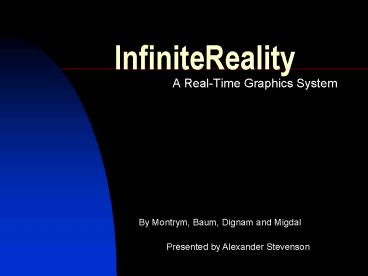InfiniteReality - PowerPoint PPT Presentation
1 / 24
Title:
InfiniteReality
Description:
Integrate well with different host platforms (Onyx and Onyx2) Alexander Stevenson ... Dynamic Video Resizing. What do we do for fill ... Video Configurability ... – PowerPoint PPT presentation
Number of Views:14
Avg rating:3.0/5.0
Title: InfiniteReality
1
InfiniteReality
- A Real-Time Graphics System
By Montrym, Baum, Dignam and Migdal
Presented by Alexander Stevenson
2
Introduction
- System Goals (applications)
- Features
- History
3
Introduction System Goals
- Render LOTS of lighted, smooth shaded, depth
buffered, texture mapped, antialiased triangles. - Allow complex visual simulations, with constant
update rates of 60Hz . - Integrate well with different host platforms
(Onyx and Onyx2)
4
Introduction Features
- First high-end SGI system to natively support
OpenGL. - Support for virtual texture memory (through
clip-mapping and DMA texture loading/paging) - Scene load management
- Configurable Video Output
5
Introduction History
- InfiniteReality was introduced in 1997
- This was the same time as Pentium IIs, the G3,
and - The 3Dfx Voodoo 1?!?!?!
- "Pure3D's 4MB of texture memory and TV-out
capabilities add a new twist to our technology
that PC gamers are sure to enjoy. 3Dfx, August
25, 1997
6
Architecture
- Three parts
- Geometry
- Host interface, 4 Geometry Processors
- Raster Memory
- Fragment generator, 80 image engines
- Display Generator
- Drive up to 8 output channels, each with own
video timing, gamma correction
7
Architecture
8
Features
- Virtual Textures
- Clip-maps
- Loading and Paging
- Scene Load Management
- Video Configurability
9
Virtual Textures
- Virtual Textures are textures too large to fit
in physical texture memory - Instead they are stored in system RAM, and
accessed using DMA - Previous methods required breaking up large
textures into small pieces - 1 piece per fragment
- Clip-maps are used to get around this
10
Virtual Textures Clip-Maps
- If screen resolution is 1024x768, we cant see
more than 1024x768 pixels of texture at one time - We can use this to our advantage
11
Virtual Textures Clip-Maps
- Weve all seen mip-maps
- A clip-map is like a subset of a mip-map,
centered on where the user is looking in a
texture - (Keep in mind that we cant see more than 1
framebuffer worth of any texture at a time)
12
Virtual Textures Clip-Maps
- Because the clip-map contains only a portion of
the texture, it needs to be updated as the
viewers position changes - InfiniteReality does this intelligently so that
we dont need to replace all the data each time
we recalculate the clip-map - This method allows scenes to be drawn as though
the entire mip-map was resident in texture memory
13
Virtual Textures Clip-Maps
14
Virtual Textures Clip-Maps
- Clip-maps require much less memory than mip-maps
to store - Also, InfiniteReality is clever enough to use the
best detail level available, if for some reason
the clip-map of the desired area isnt available
in the desired quality.
15
Virtual Textures Loading and Paging
- Loading and paging is minimized by native support
for OpenGL texture formats. - Geometry system does pixel unpacking and format
conversion - DMA hardware handles stride and address
arithmetic
16
Features
- Virtual Textures
- Scene Load Management
- Pipeline Performance Statistics
- Dynamic Video Resizing
- Video Configurability
17
Pipeline Performance Statistics
- We want to keep frame rates high.
- System provides a mechanism for detecting
Geometry-Raster stalls, as well as stalls in
upstream Geometry path. - This allows us to detect fill-limited or
geometry-limited scenes, respectively. - The application can then reduce the complexity of
a scene as necessary, to avoid geometry
bottlenecks.
18
Dynamic Video Resizing
- What do we do for fill-limited scenes?
- Each frame, fill requirements are analysed.
- If necessary, frames can be drawn at a lower
resolution, and then digitally scaled up by the
video hardware. - In practice, we can often reduce the resolution
up to 25 in each dimension, without
substantially degrading the image quality.
19
Features
- Virtual Textures
- Scene Load Management
- Video Configurability
20
Video Configurability
- Anyone who has done stereo or multiple monitors
on the Onyx has used ircombine - This allows a user to dynamically select
different formats, sections of framebuffer, pixel
depth, pixel size, and other attributes for each
video output. - To see this in action, check out FSC 23??
21
Performance
- Infinite Reality was really good at the time.
- IR 11.3 million triangles per second
- Voodoo 3 million triangles per second
- Now, NVIDIA GeForce 2 Ultra does
- 31 million triangles per second
22
Performance
- Dont let the numbers fool you InfiniteReality
wasnt built to draw unlit, untextured triangles. - Designers put a lot of effort into optimizing for
OpenGL mode switches, and support for large
textures, and InfiniteReality may well win out in
cases that use these.
23
Conclusion
- In the room with 1 Onyx, and 4 Linux based
GeForce 2 machines, few even know the Onyx is
there. Nobody is asking to use it. - With graphics accelerators improving so rapidly,
expensive SGI workstations provide less
bang-for-the-buck. - For VR (which needs stereo), or CAVEs (which need
multiple displays), InfiniteReality is still king.
24
The End


























